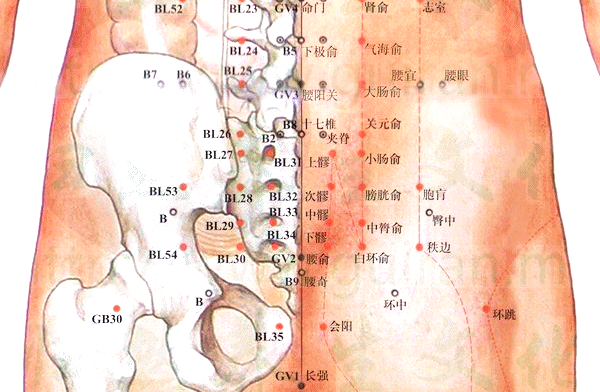The Luo Vessels are branches that diverge from the main meridians, serving to enhance the connection and regulation between the Yin and Yang of the interior and exterior. Each of the twelve meridians and the Ren and Du meridians has a separate Luo vessel, along with the large Luo of the Spleen, totaling fifteen Luo vessels.
The Governing Vessel Luo, one of the fifteen Luo vessels. The branch Luo vessel of the Governing Vessel is called Changqiang, which ascends alongside the spine to the nape of the neck, dispersing over the head; it then descends between the two shoulder blades, diverging left and right along the Foot Taiyang Bladder Meridian, penetrating deeply through the spine.
The pathological changes associated with it include a real pattern of spinal rigidity and a deficiency pattern of heaviness in the head and unsteadiness; these are both due to the dysfunction of the Luo vessel of the Governing Vessel, and the Luo point Changqiang can be used for treatment.
【Changqiang Point】

Changqiang, from the “Lingshu: Meridians”. Other names include: Qionggu, Juegu, Qi’s Yinxi, Chest’s Yinxi, Qixi, Tailbone, Tail Cui Bone, Tail Lu, Sacral Upper, Sacral End, Bone Sacrum, Turtle Tail, Longhu, Tail Maggot Bone, Sacrum, Caoxi Road, Sanfen Lu, Heche Road, Chaotian Ridge, Yun Chu, Shangtian Ladder, Tailbone Lower Point, Jizhong End, Lower Extreme. Chang, in contrast to short, means long and vigorous. Qiang implies strength and vigor. The Governing Vessel governs all Yang meridians, ascending from below, strong and long, serving as the foundation for the entire body. Changqiang represents pure Yang at its inception and is the Luo point of the Governing Vessel, with strong Qi. Yang Shangshan said: “The Yang meridians of the Governing Vessel are long, their Qi is strong, and the point resides there, hence it is called Changqiang.” If it is long but not strong, it leads to fatigue and difficulty in support; if it is long but overly strong, it causes the spine to bend backward, both conditions can be treated. The endless cycle is called long, and the vigorous movement is called strong. Health practitioners adjust the Ren and Du meridians, guiding Qi with intention, starting from the tailbone, following the spine, reaching the Baihui, descending to the Yinjiao, connecting with the Ren meridian, descending to the chest, reaching the navel and perineum, and rejoining the Governing Vessel. Following this point along the back, it is what Zhuangzi referred to as “following the Governing Vessel as a meridian.” Thus, the rising and falling cycles continue endlessly, hence the name Changqiang.
Location: At the lower end of the tailbone, at the midpoint of the line connecting the tailbone and the anus.
Method of Acupuncture: Lying on the back with knees bent, the midpoint of the line connecting the tailbone and the anus is the point.
Functions: Relieves spasms and pain, regulates urination.
Indications: Disorders of the anterior and posterior Yin and mental conditions, such as vulvar itching, scrotal eczema, prostatitis, nocturnal emissions, impotence, yellow and difficult urination, hemorrhoids, prolapse of the rectum, enteritis, dysentery, constipation, blood in stool, schizophrenia, spinal rigidity, convulsions, infantile fontanelle depression, lumbar pain, coccygeal pain, hemorrhoids, enuresis, diarrhea, dysentery, hysteria, urinary retention, urinary disorders, difficult urination, genital itching, hematemesis, hernia, epilepsy, diarrhea, difficulty in urination and defecation, hysteria, lumbar nerve pain, etc.
Needling Technique: Oblique insertion, with the needle tip directed upwards and parallel to the sacrum, inserting 0.5 to 1 inch. Do not penetrate the rectum to prevent infection.
Moxibustion Technique: Generally not moxibusted.
Massage Technique: Sitting upright, lean forward, one hand reaches behind the hips, using the middle finger to press and rub the Changqiang point vigorously for 1-3 minutes each morning and evening, which can treat constipation, hemorrhoids, and rectal prolapse, and quickly stop diarrhea.

